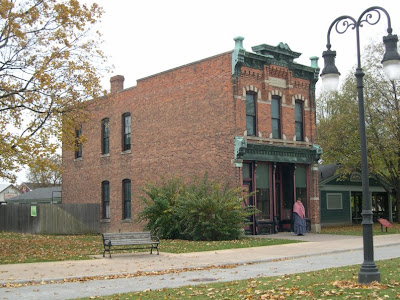Firestone Farm: Yard, Barn, and Other Outbuildings
 The Firestone Farm is a real working farm, and the presenters can be found working the land seasonally, just as it was done in the 19th century: tilling, harrowing, planting, and doing all of the other chores typical of the era. It is a living history re-creation of life on a farm of the 1880's in Eastern (Columbiana) Ohio, and the presenters who work the farm have done a marvelous job in their presentation of this life.
The Firestone Farm is a real working farm, and the presenters can be found working the land seasonally, just as it was done in the 19th century: tilling, harrowing, planting, and doing all of the other chores typical of the era. It is a living history re-creation of life on a farm of the 1880's in Eastern (Columbiana) Ohio, and the presenters who work the farm have done a marvelous job in their presentation of this life.At the end of this posting, click the link to see how hog butchering was done in the 1880's.
 Numerous livestock call the farm home, including draft horses, cattle, pigs, chickens, and the aforementioned sheep. Some roam about the barnyard freely, while the larger animals are fenced in.
Numerous livestock call the farm home, including draft horses, cattle, pigs, chickens, and the aforementioned sheep. Some roam about the barnyard freely, while the larger animals are fenced in.But, one can get close to them as they walk into the barn out back. Beware, however: the odors of a country farm are prominent!
The barn is known as a Pennsylvania-German bank barn, one of the most common barns built before 1880. They are known as bank barns because one side of the barn is built into the side of a hill, allowing wagons to be driven into the upper floor while the animals were kept in the lower level.
 This bank barn, built in 1830, was efficient because large amounts of grain and hay could be processed and stored in the upper level and tossed down to the lower level as needed for cattle feed.
This bank barn, built in 1830, was efficient because large amounts of grain and hay could be processed and stored in the upper level and tossed down to the lower level as needed for cattle feed.It was moved to Dearborn, Michigan and restored in Greenfield Village in 1983.
 The visitor is welcome to stroll through both levels of the barn, taking in the sites (and smells!) of rural life gone by.
The visitor is welcome to stroll through both levels of the barn, taking in the sites (and smells!) of rural life gone by.Springtime at Firestone Farm is the time for plowing the fields. The workers always take the time to answer any questions visitors may have. As you can see, the farm yard covers quite a bit of ground.


Just off to the side of the house is the dairy barn.
 Yes, it is also the place where the presenters get there water, just as the Firestones did 150 years ago.
Yes, it is also the place where the presenters get there water, just as the Firestones did 150 years ago. Here a presenter explains how churned butter is put inside the dairy barn to set before it can be used in cooking.
Here a presenter explains how churned butter is put inside the dairy barn to set before it can be used in cooking.And behind the main house is the necessary, better known today as the outhouse.

 Eggs were collected daily by the women and younger children of the family.
Eggs were collected daily by the women and younger children of the family. Visitors can also see some of the seasonal cooking crafts, such as apple butter making.
Visitors can also see some of the seasonal cooking crafts, such as apple butter making. In the fall, the presenters actually butcher the hogs as was done in the later 19th century. Here is an excellent film clip from youtube on the process, filmed at Firestone:
In the fall, the presenters actually butcher the hogs as was done in the later 19th century. Here is an excellent film clip from youtube on the process, filmed at Firestone:Hog Butchering at Firestone Farm
The Firestone Farm and barn truly make for an authentic living history experience. One can spend hours watching and speaking to the presenters. This is probably my favorite area of Greenfield Village.
.



Comments